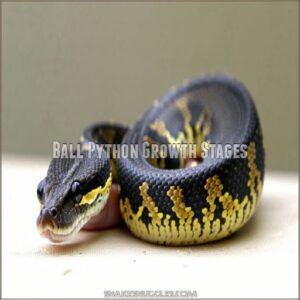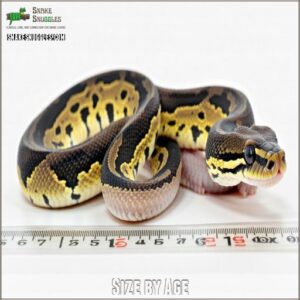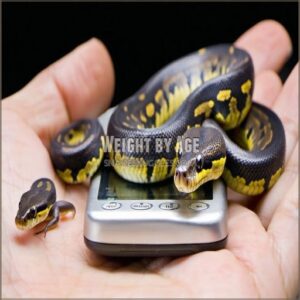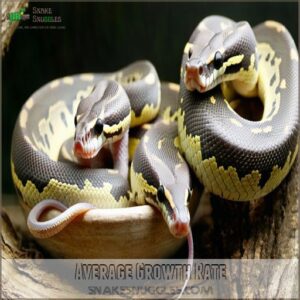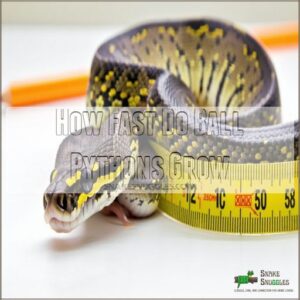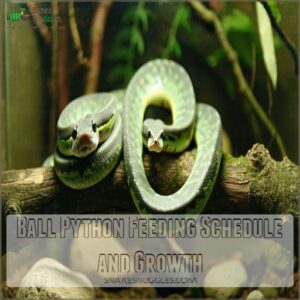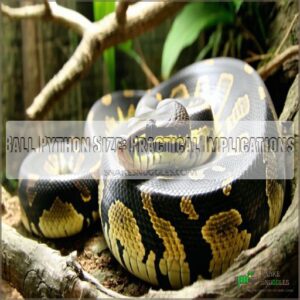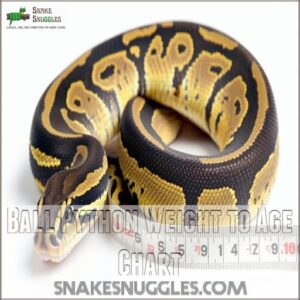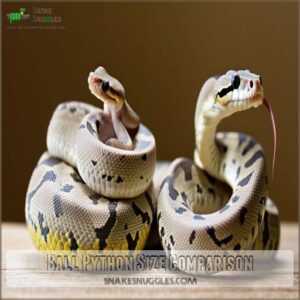This site is supported by our readers. We may earn a commission, at no cost to you, if you purchase through links.
 As a ball python parent, you’re probably wondering, "How big do these snakes really get?"
As a ball python parent, you’re probably wondering, "How big do these snakes really get?"
Well, good news – they don’t grow to be huge monsters!
The average adult ball python is around 3-5 feet long, with females on the larger end at 5 feet or more.
Males tend to stay on the smaller side, around 2-3 feet.
As for weight, healthy adults usually range from 3.5 to 6 pounds.
But don’t worry, their size is just part of their charm!
With proper care and feeding, your scaly friend will grow at a steady, manageable pace.
Curious to learn more about keeping your ball python happy and healthy?
Keep reading!
Table Of Contents
- Key Takeaways
- Ball Python Growth Stages
- Ball Python Full Grown Size
- Factors Influencing Ball Python Size
- Ball Python Growth Chart
- How Fast Do Ball Pythons Grow
- Ball Python Feeding Schedule and Growth
- Ball Python Size: Practical Implications
- Reasons Why a Ball Python Might Not Be Growing
- Ball Python Weight to Age Chart
- Ball Python Size Comparison
- Frequently Asked Questions (FAQs)
- How big should a ball python enclosure be?
- How big do pythons get?
- What does a ball python look like?
- How big do ball pythons get?
- What is a ball python?
- How much does a female ball python weigh?
- How big are full grown ball pythons?
- Can a ball python live in a 40 gallon tank?
- How aggressive are ball pythons?
- How big of a tank do I need for a ball python?
- What are the ideal tank dimensions for a ball python?
- How long does it take for a ball python to reach full size?
- Are there any growth supplements for ball pythons?
- Can exercise affect a ball pythons growth rate?
- How do I properly transition my ball pythons prey size?
- Conclusion
Key Takeaways
Here are 4 key takeaways about ball python size:
- As adults, ball pythons typically reach 3-5 feet long, with females on the larger end at up to 6 feet.
- Proper habitat, diet, and care are crucial for supporting healthy growth – pay close attention to your snake’s feeding schedule and prey size.
- Growth rates vary based on factors like sex, age, and husbandry, but you can expect your ball python to reach full size within 2-3 years.
- While impressive, ball pythons’ moderate size makes them a great choice for beginner and experienced reptile keepers alike.
Ball Python Growth Stages
As your ball python grows, it’ll go through distinct stages – from tiny hatchling to full-grown adult.
Understanding these growth phases will help you prepare for how big your scaly friend can get and make sure they’ve the right-sized home.
Hatchling Size and Weight
Out of the egg, ball python hatchlings are miniature marvels, measuring a mere 10 to 17 inches long at birth.
Their delicate frames weigh just 50 to 80 grams, a feathery fraction of their full-grown selves.
To guarantee healthy hatchling development, monitor weight gain closely and provide an appropriately sized enclosure with a steady diet of appropriately sized prey.
Juvenile Growth Patterns
As your juvenile ball python grows, they’ll experience noticeable growth spurts.
During this phase, around 6 to 9 months old, males typically reach 20 to 25 inches, while females hit 25 to 30 inches.
Their feeding schedule will increase to about once a week to support this rapid development.
Keep an eye on their shedding patterns too – this is a sign of healthy growth.
| Age | Male Size | Female Size |
|---|---|---|
| 6 Months | 20-25 in | 25-30 in |
| 9 Months | 20-25 in | 25-30 in |
| 12 Months | 24-30 in | 30-36 in |
| 18 Months | 30-36 in | 36-42 in |
Sub-Adult Development
Your ball python’s leap from juvenile to sub-adult is like a teen sprouting overnight!
Expect noticeable growth—females surpassing three feet, males comfortably reaching around two to three feet.
Sub-adult feeding adjustments with more substantial meals are needed as their appetite expands.
Keep their enclosure stimulating to match their growing curiosity and manage sub-adult shedding and handling gracefully to help them thrive.
Adult Size and Weight
Adults often reach their peak size and weight three years in, with females boasting a length of 3 to 5 feet and males smaller at 2.5 to 3.5 feet.
You’ll notice that adult size variation depends heavily on sex and diet.
Aim for good weight management by ensuring a balanced diet and proper feeding guidelines to avoid potential health concerns.
Ball Python Full Grown Size
Most pet ball pythons typically max out at 4 to 6 feet long, with females growing larger than males.
In fact, a full-grown adult ball python is usually around 3 to 5 feet long.
To understand proper care and housing, it’s important to understand the adult ball python size and its requirements.
While their size may vary depending on factors like diet and husbandry, you can generally expect your pet ball python to reach its full mature length within 2 to 3 years.
Factors Influencing Ball Python Size
Did you know that the size of your beloved ball python isn’t just a matter of genetics?
Factors like sex, habitat, diet, and activity level all play a role in determining how big these fascinating pets can get.
Sex and Growth Rate
While females are always bigger than males, their growth rates also differ.
Females grow about 1.5 times faster, reaching up to 6 feet long.
Males max out around 3.5 feet.
This sex-based size gap is important to keep in mind when breeding or housing ball pythons, as their mature dimensions impact care requirements.
Husbandry and Enclosure Size
Proper husbandry is key to your ball python’s growth.
Their enclosure should accommodate their full adult size – typically 40 gallons or larger for most adults.
For ideal tank size requirements, consider factors such as snake length and girth, as the tank should be at least 1.5 times the snake’s length.
Look for a tank with good ventilation, ideal substrate, and proper heating to create a comfortable environment.
The right enclosure can directly affect a pet’s health and allows them to thrive.
Diet and Feeding Schedule
Consistent and appropriate feeding is key to your ball python’s growth.
Provide the right prey size at the right frequency based on their age and size.
Supplements like vitamins can support healthy development too.
Careful, though – food strikes and overeating can both slow growth.
Focus on your snake’s unique nutritional needs for best results.
Exercise and Health
Keeping your ball python active and healthy is very important for good growth.
Encourage regular movement by adding stimulating elements to their enclosure, like sturdy branches or climbing rocks.
Avoid obesity by providing the right prey size and frequency.
Monitor your snake’s weight and energy levels to catch any potential health issues early on.
With the right enrichment and care, your ball python will thrive and reach its full size potential.
Ball Python Growth Chart
Wondering just how big your pet ball python can get?
Our detailed growth chart has the answers!
From tiny hatchlings to full-grown adults, you’ll discover the average sizes and weights these fascinating reptiles reach at every stage of their lives.
Size by Age
As your ball python grows, you’ll see some fascinating changes.
Hatchlings start around 10-17 inches, then juveniles reach 20-30 inches by 6-9 months.
Sub-adults hit 2-3.5 feet by 9-18 months, and adults max out at 2.5-6 feet by 3 years old.
It’s important to monitor their growth rate, as ball pythons can increase approximately 30-40 inches in their first year, as discussed in ball python time to grow.
Check this handy size chart to track your snake’s development:
| Age | Male | Female |
|---|---|---|
| Hatchling | 10-17 in | 10-17 in |
| Juvenile | 20-25 in | 25-30 in |
| Sub-Adult | 2-3 ft | 2.5-3.5 ft |
| Adult | 2.5-3.5 ft | 3-5 ft |
Weight by Age
Hatchlings typically range from 50 to 80 grams.
Juveniles (6-9 months) can vary from 275 to 360 grams for males and 300 to 360 grams for females.
By one year old, they’ll likely weigh 500 to 800 grams.
Tracking your ball python’s weight helps make sure it’s growing at a healthy pace. Regularly monitoring its growth also ensures that you can adjust its diet and habitat accordingly, such as feeding rodents almost as wide as the snake’s girth for efficient digestion guidelines.
Average Growth Rate
Your ball python’s growth rate can vary quite a bit.
Males tend to reach maturity around 18 months, while females take a bit longer at 24 months.
With proper care, most young snakes pack on the pounds in the first year.
Look for steady weight gain and frequent shedding – signs your pet is thriving.
How Fast Do Ball Pythons Grow
Did you know ball pythons grow at wildly different rates depending on their age and sex?
While hatchlings start around a foot long, females can reach up to 6 feet as adults, growing 1.5 times faster than the males.
It’s all about proper care and a healthy diet to keep your scaly friend growing big and strong.
Growth Rate by Age
Ball pythons show impressive growth during their first year, typically reaching about half their adult size.
Growth Rate can provide valuable insights into their overall health and development.
The rapid development slows as they mature, with most reaching full length between 2-3 years old.
Factors Affecting Growth Speed
Genetics play a major role in your ball python’s growth rate.
Think of it as their blueprint—dictating potential size.
Understanding the ball python growth stages is also key, which can be better achieved by checking out ball python growth products.
But, environmental factors like temperature and humidity can tip the scales.
Too cold? Growth slows.
Too dry? Stress skyrockets, stalling development.
Nutrition is the fuel, dictating their energy for growth.
Keep an eye on the ball python weight and adjust their diet accordingly to foster healthy growth.
Signs of Healthy Growth
Healthy ball pythons shed regularly, gain weight steadily, and maintain a healthy appetite.
Their activity level is energetic, and their coloration vibrant.
These signs indicate your pet is on track to reach its full size.
Carefully monitor your snake’s growth – a well-paced progression means you’re doing it right!
Ball Python Feeding Schedule and Growth
As your ball python grows, you’ll need to adjust its feeding schedule to match its changing size and appetite.
Don’t worry, we’ll walk you through the ins and outs of feeding your scaly pal so they stay healthy and happy.
Feeding Frequency by Age
Your ball python’s growth rate will require adjustments to its enclosure size, starting with a 10-gallon tank for juveniles, as explained in ball python care basics. Your feeding schedule will change as your ball python grows.
As hatchlings, they eat every 5-7 days, which is essential for supporting their rapid growth and high metabolism, as discussed in the proper baby ball python feeding frequency.
Juveniles need food every 7-10 days.
Sub-adults shift to eating every 10-14 days.
By adulthood, most ball pythons do well with a weekly feeding.
- Hatchling: 5-7 days between meals
- Juvenile: 7-10 days between meals
- Sub-Adult**: 10-14 days between meals
- Adult: Weekly feeding
Prey Size and Type
Feeding your ball python the right size and type of prey is essential.
As your snake grows, you’ll need to change to larger prey.
Use this handy guide to determine the right sized rodent based on your python’s length:
| Snake Length | Prey Size |
|---|---|
| Under 3 ft | Small Mouse |
| 3-4 ft | Medium Mouse |
| 4-5 ft | Large Mouse/Small Rat |
| Over 5 ft |
Supplements and Vitamins
Properly supplementing your ball python’s diet is key.
Look for calcium and vitamin D3 supplements to meet their special needs.
Reputable brands like Fluker’s or Zoo Med offer safe options.
Follow dosage recommendations – too little or too much can cause issues.
Provide a balanced diet and healthy supplements for your ball python to thrive.
Ball Python Size: Practical Implications
As your ball python grows into an adult, you’ll need to make some adjustments to their living space and handling.
Larger ball pythons can thrive in tanks ranging from 75 to 120 gallons for optimal growth and lifespan, as explained in the ball python tank size requirements. Larger ball pythons require spacious enclosures and careful caretaking,
but with the right preparations, you can continue providing your scaled friend with a comfortable, safe home.
Housing and Enclosure Requirements
As your ball python grows, you’ll need to upgrade its enclosure.
Aim for at least a 40-gallon tank that accommodates the snake’s full length.
Choose an appropriate substrate, maintain the right temperature gradient, and make sure there’s proper ventilation.
With the right housing, your slithery buddy can thrive.
Handling and Safety Precautions
Ball pythons typically grow to a manageable size of 2 to 5 feet in length as adults, with females generally larger than males, requiring consistent temperature gradients with a warm and cool spot. Larger adult ball pythons require careful handling due to their strength and weight.
Maintain a firm but gentle grip, supporting the snake’s full body.
Avoid restraining too tightly or triggering defensive behaviors.
Be mindful of their powerful coils and sharp teeth – wear gloves if needed.
Proper setup and gradual acclimation help make sure safe interactions.
Feeding and Nutrition
Adult ball pythons require a thoughtful feeding regimen.
Mice or rats should be the right size – no larger than the widest part of the snake’s body.
Stick to a feeding schedule, providing the right prey quantity and frequency.
Supplements like calcium and vitamins can help avoid nutritional deficiencies.
Get the feeding just right, and your ball python will stay healthy and grow strong.
Reasons Why a Ball Python Might Not Be Growing
If your ball python isn’t growing as expected, there could be a few reasons why.
Underfeeding, stress, or health issues may be slowing its growth.
While an overabundance of food can lead to obesity and finicky eating habits.
Underfeeding and Malnutrition
Underfeeding and not providing the right nutrition can stunt your ball python’s growth.
Signs include a thin, lanky body and dull, dry skin.
For best growth, make sure you’re aware of your snake’s growth stages, such as the hatchling growth stage, which requires regular small meals and a secure warm space.
Follow a proper feeding schedule with appropriately sized prey, and be sure to supplement with vitamins.
Skimping on food will leave your snake unhealthy and undersized.
- Stick to the recommended feeding guide for your ball python’s age and size.
- Avoid common mistakes like not offering enough food or the wrong prey type.
- Make sure your snake is getting a balanced diet to support healthy growth.
Stress and Health Issues
Stress and health problems can also slow your ball python’s growth.
Maybe your snake’s feeling anxious in their tank or has an underlying medical issue.
The solution? Make sure you’re providing proper husbandry, minimize disturbances, and get your vet’s advice if growth seems stunted.
With the right care, your python will thrive.
Obesity and Food Strikes
Obesity and excessive weight can also hinder your ball python’s growth.
While "food strikes" – abruptly refusing to eat – may seem concerning, it’s often your snake’s way of regulating their intake.
To keep your pet healthy, make sure their enclosure meets their needs and provide a balanced diet suited to their size.
Ball Python Weight to Age Chart
Curious about your ball python’s weight?
Our detailed weight-to-age chart takes the guesswork out, so you can make sure your scaly friend is growing right on track.
From hatchling to adult, we’ve got the numbers you need to keep your pet pythoning along healthily.
Average Weights by Age
Alongside tracking your ball python’s length, a suitable enclosure size should be considered, such as the recommended terrarium size, closely monitoring its weight is key.
From hatchlings weighing 50-80 grams to adults up to 2,000 grams, check this handy table to see where your pet falls:
| Age | Male Weight | Female Weight |
|---|---|---|
| Hatchling | 50-80 g | 50-80 g |
| Juvenile | 275-360 g | 300-360 g |
| 1 Year | 500-800 g | 650-800 g |
| 2 Years | 800-1,100 g | 1,200-1,800 g |
| 3 Years | 900-1,500 g | 1,200-2,000 g |
Factors Affecting Weight
Your ball python’s weight can fluctuate due to a variety of factors.
Genetics play a big role – females naturally grow more rapidly.
Metabolism, influenced by things like feeding schedule and tank temperature, also affects size.
And stress from an improper habitat or health issues can definitely slow their growth.
Pay close attention to these key factors to keep your pet on track.
Measuring and Recording Weight
Regularly weighing your ball python is key to monitoring growth.
You can find a suitable weight scale for snakes at a pet supply store using a resource like reptile weight scales.
Use a precise scale to log weight each month – this reveals any unusual fluctuations.
Aim for a healthy weight range based on your snake’s age and size.
If they’re underweight or overweight, adjust feeding to promote steady, sustainable growth.
Tracking this data helps make sure your pet stays in tip-top shape.
Ball Python Size Comparison
Ball pythons can grow up to 3 feet in length, at which point they require a larger enclosure, such as a 48" x 24" x 24" ball python enclosure. Wondering how the size of your pet ball python stacks up?
Don’t worry, we’ve got you covered!
From hatchling to full-grown, we’ll break down how ball pythons measure up to other popular pets.
Size Comparison to Other Python Species
Undeniably, ball pythons are a more petite breed compared to their larger python cousins.
For example, the mighty Burmese python can reach over 20 feet in length, while the reticulated python is known to grow over 25 feet.
Even the South American green anaconda, the heaviest snake in the world, commonly measures 12-15 feet long.
In contrast, ball pythons:
- Typically max out at 5-6 feet for females
- Average around 3-4 feet for males
- Rarely exceed 6 feet, even for the largest specimens
- Offer a more manageable size perfect for first-time snake owners
So while ball pythons boast impressive size and strength, they remain one of the more compact python options, making them an excellent choice for amateur reptile enthusiasts.
Size Comparison to Common Pets
When comparing a full-grown ball python to familiar household pets, the size differences are quite striking. Imagine this – a ball python can reach lengths of up to 6 feet, dwarfing even the largest house cats at around 3 feet.
An adult ball python could easily outsize the average dog, standing tall at 3-5 feet. And when you consider a typical guinea pig or hamster, the ball python appears downright gigantic, measuring over 10 times their size!
Understanding these size comparisons can help you properly prepare for and accommodate your ball python’s ample space needs as it matures.
An adult ball python’s habitat requirements are essential, which is why choosing the right Ball Python Cage is essential for its well-being.
| Pet | Average Size |
|---|---|
| House Cat | 3 feet |
| Dog | 3-5 feet |
| Guinea Pig | 1 foot |
| Hamster | 6 inches |
Frequently Asked Questions (FAQs)
How big should a ball python enclosure be?
You won’t believe this, but your ball python needs a spacious home.
We’re talking at least a 40-gallon tank, folks.
Anything smaller, and your slithery friend might start feeling a bit claustrophobic.
How big do pythons get?
Ball pythons can reach impressive sizes, with females growing up to 6 feet long and males topping out around 5 feet.
Ball pythons start tiny, hatching at just 10-17 inches.
Their size depends on factors like sex, diet, and care.
What does a ball python look like?
A ball python has a stocky, muscular build with a broad head and a constricting body.
Their scales come in a variety of colors and patterns, often featuring eye-catching brown, black, and yellow hues.
How big do ball pythons get?
Well, let me tell you, these snakes can really pack a punch!
Depending on their sex, ball pythons typically reach 5 to 6 feet long, with females being the larger of the two.
Quite the impressive size, wouldn’t you say?
What is a ball python?
When caring for a full-grown ball python, you need to think about spacious housing—at least a 4ft x 2ft x 2ft vivarium—to accommodate its size and provide comfort.
Large adults require proper heating with a temperature gradient, and a diet of appropriately sized prey, like rats.
A setup mimicking their natural environment with hides, climbing branches, and correct humidity levels enhances their well-being.
Keeping a ball python involves understanding its habitat needs to create a thriving home.
How much does a female ball python weigh?
As a nourishing nurturer, the female ball python can weigh a whopping 1,200 to 2,000 grams.
These serpentine stunners pack quite a punch, so handle with care and provide proper provisions for their proportions.
How big are full grown ball pythons?
Full-grown ball pythons can reach impressive lengths, with males typically measuring 5 to 5 feet and females growing even larger, up to 6 feet! But don’t worry, they’re gentle giants at heart.
Can a ball python live in a 40 gallon tank?
Yes, you can house an adult ball python in a 40-gallon tank.
Floor space
Just make sure to provide enough floor space for the snake to move around comfortably and add hiding spots to help your pet feel secure.
How aggressive are ball pythons?
Easy does it, friend! Ball pythons may look scary but they’re total softies.
With a little TLC, they’ll warm up quicker than you’d think.
Just take it slow and steady, and you’ll be BFFs in no time.
How big of a tank do I need for a ball python?
For a ball python, a 40-gallon tank is ideal for adults.
Hatchlings thrive in smaller spaces, but as they grow, you’ll need more room.
Think cozy but spacious, like upgrading from a studio to a big apartment!
What are the ideal tank dimensions for a ball python?
A well-suited tank for your ball python should measure at least 40 gallons, providing ample space for the snake to move and thrive.
Don’t worry – we’ll go into more detail to make sure your pet’s comfort and healthy growth.
How long does it take for a ball python to reach full size?
Ball pythons typically reach their full size within 2 to 3 years, with females growing about 5 times faster than males.
Size
While the exact timeline can vary, most pet ball pythons will max out between 5 to 6 feet in length.
Are there any growth supplements for ball pythons?
Careful, friend – there’s no magic potion to supersize your serpent.
A balanced diet and proper care are key to healthy, steady growth.
Save your coin and focus on creating the perfect habitat – your python will love you for it.
Can exercise affect a ball pythons growth rate?
Exercise can definitely affect a ball python’s growth rate.
Providing plenty of space for your snake to move around and explore helps keep them active and healthy, supporting the best possible growth.
Just don’t overdo it – moderation is key.
How do I properly transition my ball pythons prey size?
Well, pal, switching that ball python’s grub is a delicate dance – but fear not!
Take it slow, size up the situation, and you’ll have that growing gal eating like a champ in no time.
Conclusion
While ball pythons may be on the smaller side as pets, their moderate size and manageable growth rate make them an excellent choice for many reptile enthusiasts.
With proper care, these delightful snakes can thrive for decades, providing endless hours of enjoyment.
Whether you’re a seasoned reptile keeper or a first-time snake parent, understanding ball python size and growth patterns is key to ensuring your scaly companion lives a long, healthy life.

